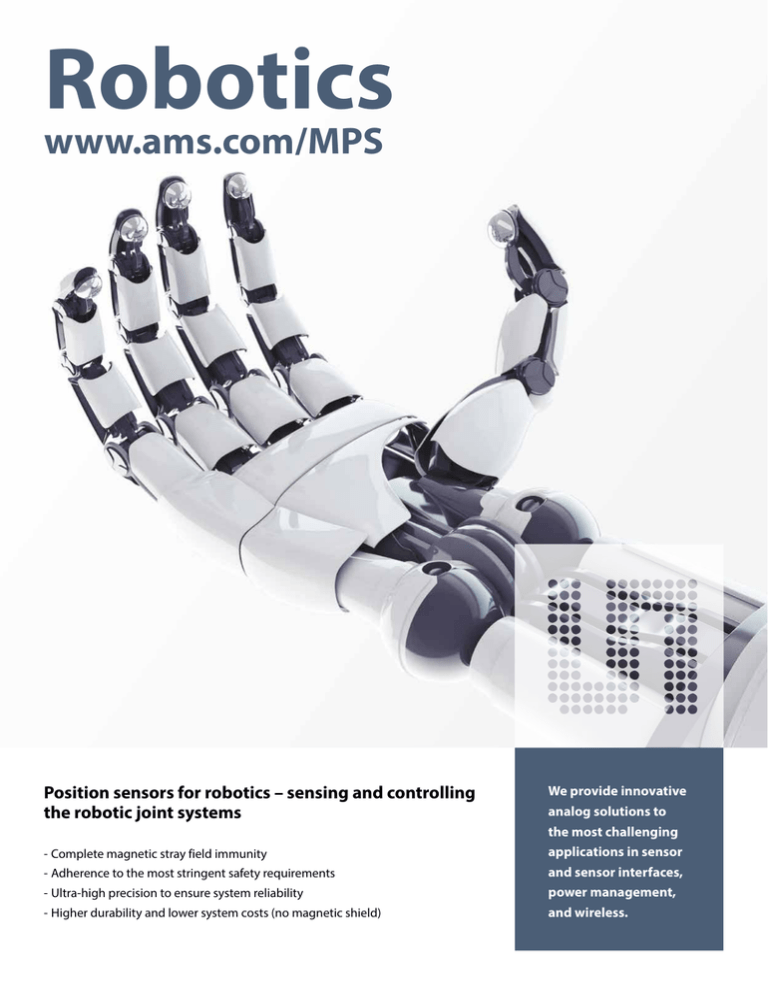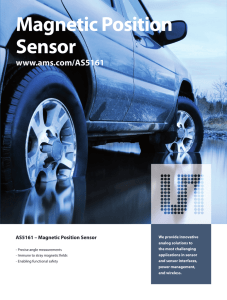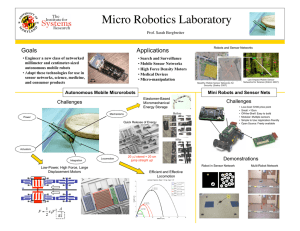www.ams.com/MPS
advertisement

Robotics www.ams.com/MPS Position sensors for robotics – sensing and controlling the robotic joint systems -Complete magnetic stray field immunity -Adherence to the most stringent safety requirements -Ultra-high precision to ensure system reliability -Higher durability and lower system costs (no magnetic shield) We provide innovative analog solutions to the most challenging applications in sensor and sensor interfaces, power management, and wireless. General Description Position sensing is key for robots to control position, orientation or motion of the robotic joints. ams’ contactless position sensors offer a high-resolution IC solution that is ideally suited for sensing and controlling the position of the joint systems for humanoid, industrial, surgical and security robots. Our position sensors are designed with ams’ patented differential sensor technology that ensures complete immunity to any external magnetic stray fields. The ICs are designed for fast and absolute-angle measurements over a full 360-degree range. Benefits - Precise and contactless angle measurement - Very low power consumption - High reliability - High precision - User programmable zero position - Absolute rotary position sensing over 360° - Immune to external magnetic stray fields Maximum Rotation Angle Output Type* Magnetic Field Range (mT) AS5048A AS5600 AS5510 360° 360° 360° linear SPI SPI, PWM Analog, PWM, I 2C I 2C 30 to 90 30 to 70 30 to 90 10 to 50 0.09 (12bit) 0.022 (14bit) 0.09 (12bit) 10 bit Supply Voltage nom. (V) 3.3 3.3 or 5.0 3.3 or 5.0 3 Maximum Supply Current (mA) 8.5 15 6.5 3.5 Power down (3µA) - Automatic (1.5mA) Power down (25µA) -40 to 85 -40 to 150 -40 to 125 -30 to 85 SOIC8 WLCSP or SOIC8 Output Resolution Low Power Mode Operating Temperature (°C) Applications AS5055A QFN-16 (4x4x0.85mm) Package TSSOP14 * Note: Automotive qualified part AS5147 (-40° - +150° Celsius) available - Robotic joint positioning - Motor position and motion control - Miniature closed-loop position control - Distance or force detection using position sensor - RC-Servo motor position feedback - Angle segment position detection - Camera lens control Target markets for advanced robotics -Industrial - Professional service - Domestic service - Security and defense -Space - Research and education - Micro and nano robots Body Part ams Solution Head In the majority of robots, acoustic, infrared, chemical or camera sensors are located in the head section. It is therefore necessary to obtain the precise angular position to control the head. In addition, the positioning of the head could also require the control of up to three axes. (AS5048 precise 14bit angular position sensor) Allows for increased camera performance, the camera modules need to integrate the focus and zoom functionality with high resolution in a very small space. (AS5600 angular position sensor with angle segment programming, AS5510, the smallest position sensor for focus or zoom functionality) Shoulder, Hip, Wrist The arms and legs of the robot are connected over the shoulder and hips. These joints are flexible on two axis, requiring very precise and reliable low-power position sensors. Often the angular range is limited to an angle segment. With angle segment programming, the full output swing can be applied to a smaller angular range. (AS5600 angular position sensor with angle segment programming, AS5055A angular position sensor with low- power consumption) Shoulder Elbow, Knee Similar to the shoulders and hip, the joints in the elbows and knees also use an angle segment sensor. Typically, these are flexible on one axis. (AS5600 angular position sensor with angle segment programming) Hip Finger Depending on the handling requirements for robots, the hands are equipped with fingers that can be robotically controlled. These actuators are limited in space and require a small-size and low-power feedback solution. Furthermore, force can be calculated by measuring a small position change of the rigid parts for the frame that are bended as a result of the load. (AS5600 angular position sensor with angle segment programming, AS5510 smallest linear low-power position sensor) Ankle Typical areas for position sensing in robots Head Elbow Wrist Finger Knee Ankle To ensure good stability, walking robots use the fast and high-resolution angle output of an angular segment sensor in the ankle joint. (AS5600 angular position sensor with angle segment programming) www.ams.com products@ams.com © 01/2015 by ams Subject to change without notice Headquarters ams AG Tobelbader Strasse 30, 8141 Unterpremstaetten, Austria Phone +43 3136 500-0 · Fax +43 3136 525-01 Sales Offices Worldwide sales-europe@ams.com sales-asia@ams.com sales-americas@ams.com





